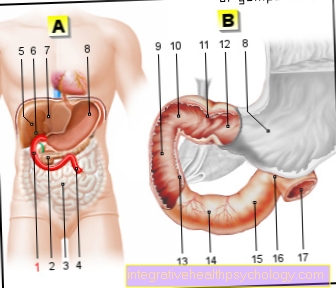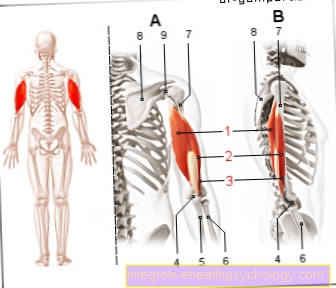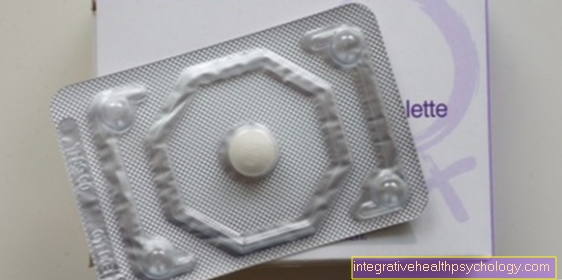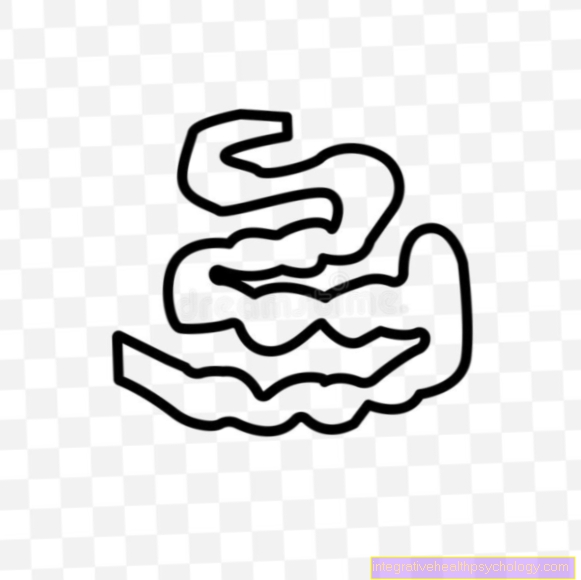Pain in and around the nasal bone
definition
Pain on the nasal bone is characterized by its localization between the forehead and the upper jaw. The nasal bone is figuratively the bone on which glasses rest on the nose. If you grasp the nose at eye level with your thumb and index finger and follow the course towards the tip of the nose, the nasal bone is the fixed, immobile part of the nose. The character of the pain can vary from dull to piercing and can be accompanied by other externally visible symptoms such as swelling, skin bleeding or nosebleeds.

causes
The causes of pain in the nasal bone can be varied. The most common reason for a sore nasal bone is force. It does not matter whether a force acts on the nose from outside or inside. A blow to the nose can be just as much a cause of an injury to the bony nose as an object that is inserted into the nose. The pain itself is caused by the injury to the bone, which can manifest itself in a bruise, a fine crack or a real break.
Read more on this topic: Broken nose
Infections of the nasal mucosa or the paranasal sinuses can also lead to a painful nasal bone, as they exert pressure on the bones from the inside through the swelling of the mucous membranes. Because of the sensitive nerve fibers of the nose, this pressure is perceived as pain.
Pain from a blow
A blow to the nose represents an externally acting force on the facial bone. Depending on the intensity of the blow, the nose bone is more or less injured. The severity of the trauma can be estimated based on the accompanying symptoms. A purely painful nasal bone is initially to be classified as less dangerous than an already optically deformed nasal bone, which is accompanied by nosebleeds and a hematoma (bruise).
Pain from a cold or runny nose
A cold is usually caused by a virus infection and is associated with swelling of the nasal mucous membranes. The nasal bone is the bony anchorage of the nose to the wider facial skull and, due to its firm structure, gives hardly any room for expansion. If the mucous membranes swell, this leads to an increase in pressure in the bony cavity of the nose. Sensitive nerve fibers are reactively stimulated and this leads to pain in the nasal bone.
Pain through glasses
Nose bone pain is a common problem for people who wear glasses. They are caused by a badly fitted glasses frame. If the contact surface of the glasses on the nose is uneven or the nose pads are too tight on the nose, sensitive nerve endings in the skin of the outer nose are irritated. They warn the wearer of possible pressure damage to the skin. Often, with the pain on the nasal bone, extensive redness occurs in the area of the contact surface and confirms the incorrect fit of the glasses. An adjustment of the glasses frame at the optician usually makes this pain disappear quickly.
You might also be interested in the topic: Inflammation of the periosteum of the nose
Bruised nasal bone
A bruise of the nasal bone often manifests itself as a very sensitive nose. In the majority of cases, there is no visible change in the nose. Swelling or a bruise are possible accompanying symptoms. In the event of a bruise, the bone is only compressed and does not show any fractures. However, the force of violence caused the plexus to become irritated and tissue to be constricted, at least for a short period of time. Micro injuries are the result. The nose is painful until the body has repaired these smallest injuries.
Broken nose
In most cases, a broken nose can be recognized by a visually different nose. However, the break not only leads to pure injury to the bone, but also to damage to its accompanying structures. The damage to the vessels usually manifests itself in nosebleeds and in the worst case can lead to skin bleeding under the eyes.
Read more on this topic: Symptoms of a broken nose
Injury to the nerves can range from pain to numbness of the nose and must be examined and evaluated on a case-by-case basis. An absolute warning signal is a clear discharge after a broken nose. If the nasal bone is pressed in towards the forehead and breaks into the frontal bone, there is a risk of damage to the brain. The brain itself is surrounded by a clear liquid as a buffer. So if there is a clear discharge after a trauma, a medical evaluation should be carried out immediately.
Concomitant symptoms
Accompanying symptoms with a painful nasal bone arise from the cause of the pain. In the case of trauma, the extent of the injury correlates with the accompanying symptoms. From a slight nosebleed to a completely deformed nose, everything is theoretically possible.
Read more on this topic: Symptoms of a broken nose
Due to the close proximity to the eyes and the upper jaw, these structures are often injured as well. Often this shows up as bleeding around the eyes or an injury to the teeth or jawbone.
In the worst case, the violence was so strong that the forehead bone broke. If the nasal bone is pressed into the skull, there is a risk of damaging the protective structures of the front brain. Absolute red flags should be a change in consciousness, loss of consciousness and a clear discharge from the nose. These symptoms can suggest that the brain has been injured. In these cases, an immediate medical clarification is urgently required.
When infected, however, fever, weakness and a general feeling of illness are often predominant. The greater the swelling of the mucous membranes, the more obstructed nasal breathing. Those affected often feel a dull pressure on the nasal bone, which can lead to headaches.
Swelling
Swelling on the nasal bone can occur both outwards and inwards. An infection mainly causes swelling inside the nose and shows up very quickly in obstructed nasal breathing. The greater the swelling, the greater the feeling of pressure on the bones. This type of swelling does not change the shape of the nose. It can only be recognized by looking into your nose. Then it shows up through constricted airways in the nose.
Read more on this topic: Swollen nasal lining
An external swelling of the nose can be seen in the mirror. The facial contours around the nose disappear to a greater or lesser extent depending on the degree of swelling. The most common cause is an injury to the nasal bone, which has led to an injury to the vessels supplying the skin. It is not uncommon for the swelling to be accompanied by visible bleeding in the skin.
a headache
If headaches occur in combination with pain in the nasal bone, this can in most cases be explained by the bony connection of the nasal bone to the frontal bone. Especially when the headache is in the area of the forehead, this suggests that changed pressure conditions on the nasal bone also affect the bony part of the forehead. The two bones are firmly fused together and cannot move against each other. Stress can therefore be transferred reactively from one bone to the other. In addition, they have the same sensitive supply from nerve fibers, so that a perception of pain in this area is not uncommon.
diagnosis
The diagnosis of pain in the nasal bone is often based on the medical history and supplemented with further diagnostic measures. In any case, the nose should always be examined. After an external inspection and careful palpation of the nose, the inside of the nose should always be examined with a nasal mirror. This examination method can usually be used to assess the cause and extent. The pain should be monitored over time.
In the event of violence, the arrangement of an x-ray, computed tomography or magnetic resonance tomography must be decided on a case-by-case basis. The more severe the trauma, the more likely it is that other structures, not least the brain, are involved. However, since the injuries are very variable, this must always be decided individually.
Treatment / therapy
Treatment for nasal bone pain depends on the cause.
In the case of infections, depending on the pathogen, only the symptoms or, if necessary, antibiotics are treated to support the healing process. The pain in the nasal bone itself can be relieved by using decongestant nasal drops. If the swelling of the mucous membrane inside the nose subsides, the tension on the bones decreases.
Read more on this topic: Nasal sprays for the treatment of inflammation of the nasal mucosa
Trauma to the nasal bone must be treated depending on the extent. In the case of bruises, local cooling of the nose several times a day for a few minutes is usually sufficient. If the nose is broken, it may be necessary to correct a malposition. Above all, it is important to exclude bleeding into the nasal septum through an examination in the case of injuries to the nose. If the dividing wall between the two nostrils is swollen and filled with blood, a so-called relief incision must be made. Otherwise, the sensitive tissue will be damaged. This damage is irreversible and would lead to impaired breathing. Once an injured nose has been treated, it is very important to take it easy. This does not include a temporary tamponade of the nostrils or even an external splint.
Read more on this topic: Therapy of a broken nose and surgery for a broken nose
Duration
The duration of pain in the nasal bone is very variable, as the causes can be of various types. In general, pain in the nasal bone as part of an infection subsides as the symptoms of the disease subside. They therefore usually last three to ten days.
If force is the cause of the pain, the duration will depend on the extent of the bone injury. Bruises usually subside within a few days and should show a clear improvement after a week at the latest. In contrast, fractures of the nasal bone can cause pain for up to four weeks. However, the principle applies that the pain should always decrease in intensity over time. An increase in pain always indicates a disturbed healing process.





























